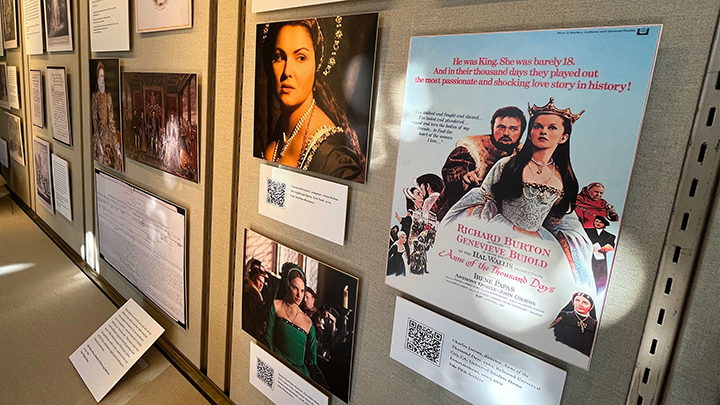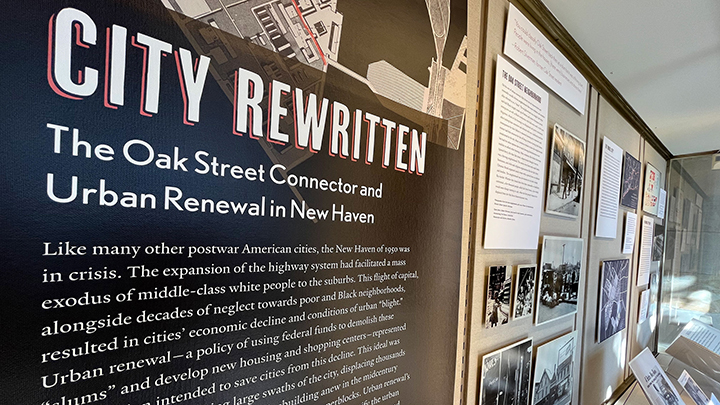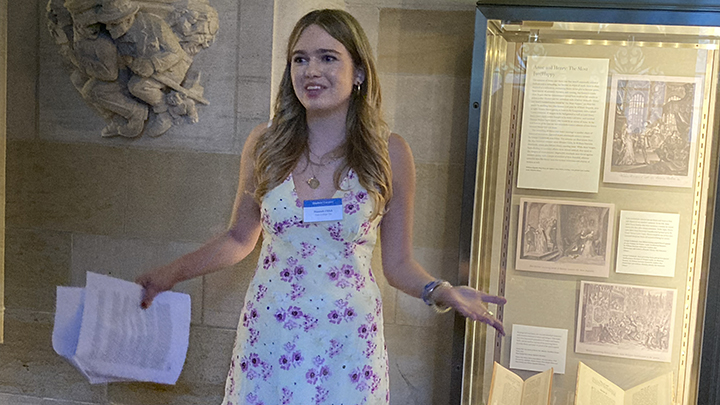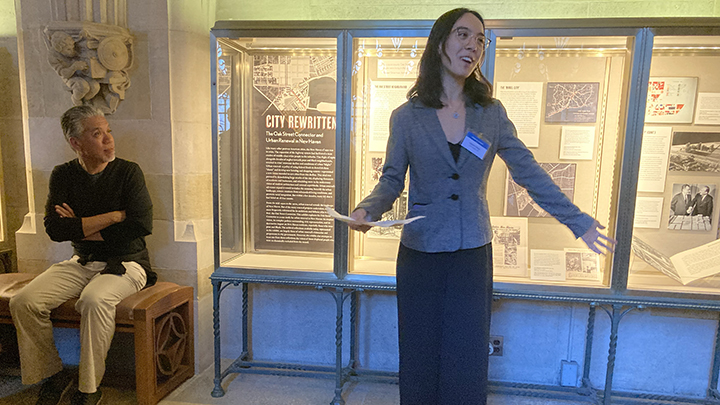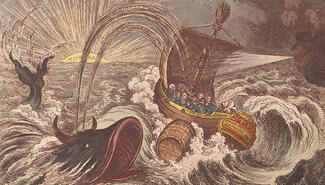An elusive queen and a highway: Two student-curated exhibits open at Sterling Library
Now on view in the exhibition corridor of Sterling Memorial Library are two exhibits curated by Yale College students through the Student Research at Yale Library program. The topics, spanning centuries, are an unlikely pairing: a survey of the life and legend of Anne Boleyn and a deep dive into one of New Haven’s mid-20th-century urban development plans. Each exhibit—based on the student’s research in Yale Library archives—tells a compelling story. Both are on view through April 21.
Anne Boleyn
“Anne Boleyn: Life and Legend” explores what is known and imagined about this influential and controversial woman—from her days in the Tudor court as Henry VIII’s ill-fated queen to the present day, when the fascination with her persists in art, literature, and film. As the curator notes, Boleyn is a mystery from the start, due to the few but unreliable portraits of her that exist.
The exhibit creates its own portrait by tracing Boleyn’s family tree, her everyday life as a powerful woman in a constraining culture, her at-first tender and then tumultuous and then deadly relationship with Henry VIII, and her long legacy—most notably through the 50-year reign of her daughter, Queen Elizabeth I, one of Britain’s greatest monarchs. The exhibit closes with modern-day portraits of Boleyn as imagined in films, novels, and elsewhere in popular culture. In conjunction with this exhibit, the Yale Film Archive will present two films in its “Boleyn and Beyond Film Series”: Elizabeth, Fri., Oct. 27, 7 pm; and The Private Life of Henry VIII, Sun., Oct. 29, 2 pm.
Curator Hannah Oblak ’24 (Pauli Murray College) is a cultural history major from New York City. Her fascination with the Tudor period and specifically with Boleyn began as a child, thanks to a novel she received from her grandmother. For this exhibit, Oblak drew materials from the collections of the Beinecke Rare Book and Manuscript Library, the Robert B. Haas Family Arts Library, the Lewis Walpole Library, the Yale Center for British Art, the Yale Film Archive, the Yale University Art Gallery, and the National Portrait Gallery, London.
“I feel so lucky to be able to share Anne’s story with visitors and the Yale community,” Oblak said. “Seeing my research come to life has truly been a highlight of my Yale experience, and I am thankful both for the opportunity and the wonderful mentorship I have received from the Yale Library team.”
View the online version of the exhibition “Anne Boleyn: Life and Legend.”
The Oak Street Connector
“City Rewritten: The Oak Street Connector and Urban Renewal in New Haven” tells the checkered story of one of the city’s failed renewal projects of the mid-1950s to 1970s: the creation of the Route 34 Expressway, known as the Oak Street Connector. This exhibit explores the planning, goals, debates, political dealings, and ultimate failure of government officials and city planners who hoped to create a “model city”—economically, culturally, aesthetically, socially. Instead, their plan disrupted nearly 3,000 residents and marred the landscape in ways that are still felt today.
To make way for the new stretch of highway, large sections of New Haven were demolished, displacing businesses and neighborhoods, having the most damaging effect on Black and immigrant communities and other residents with limited means. Critics of the Oak Street Connector, after its completion and even now, consider it “a chilling example of the worst the urban renewal could be.”
Curator Simone Herko Felton ’25 (Davenport College) is a history major from San Francisco, with an interest in curatorial work as a career. Her subjects range from urban history and modern nationalism to the Abrahamic religions. For this exhibit, Felton delved into oral histories, photographs, maps, posters, annual reports, pamphlets, and newspaper articles in the archives of the Beinecke Rare Book and Manuscript Library, the Divinity Library, and the Robert B. Haas Family Arts Library.
“It was such a privilege to take advantage of Yale’s truly impressive collections and work with such an excellent team to bring this project to fruition,” Felton said. “It’s such an unusual opportunity to be able to develop my research in this public way as an undergraduate. I’m exceedingly grateful that the Student Research at Yale Library program exists.”
Yale Library’s student-curator program
Through the Student Research at Yale Library program, two students are selected each academic year to curate two exhibit cases each. Their exhibits are based on a completed paper or research project that relies on materials in the extensive collections of Yale Library. Selected students learn all the necessary steps in translating their paper or project into a physical exhibit, with the guidance of Yale Library’s exhibit professionals.
The spring-semester-long production process leads to the opening of the students’ exhibit in the fall in the exhibition corridor in Sterling Library—with a curators’ talk and reception. This opportunity is open to Yale College sophomores and juniors and also to graduate and professional students. Proposals for the next year are due on Nov. 27. Learn more and apply.
The Senior Exhibit Fellowship at Yale Library offers rising seniors another opportunity to curate exhibits of their own design. Proposals for that program are due on March 4, 2024.
—Deborah Cannarella
Images of students at opening events by Deborah Cannarella; images of case interiors by Monica Ong Reed
